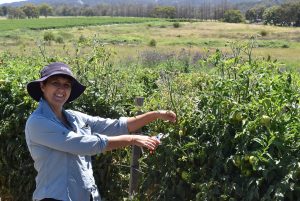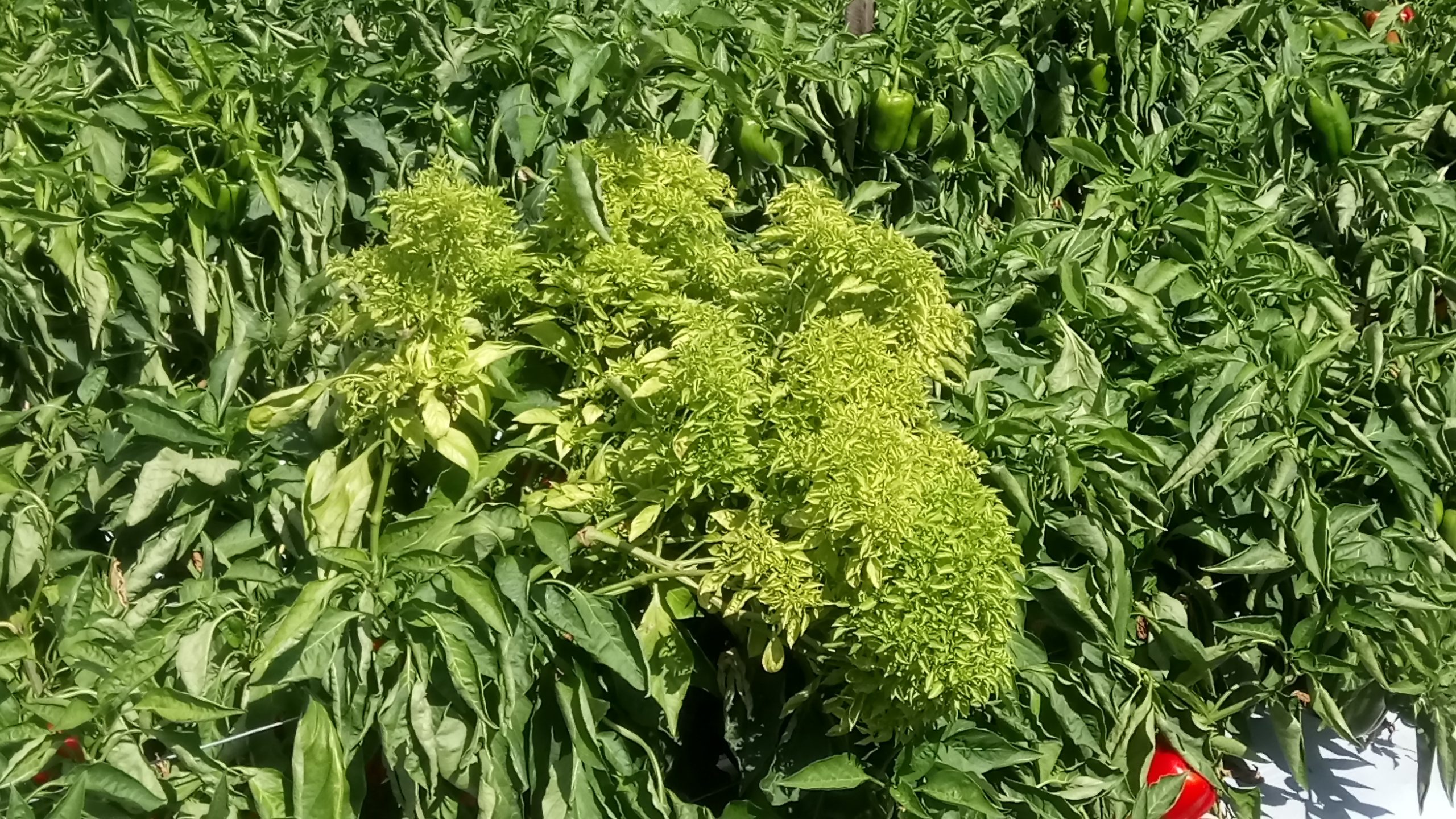Vector monitoring and disease identification activities continue
A multi-million-dollar project responsible for developing an ‘area wide management’ strategy commenced in 2018 to address high-priority viral and bacterial diseases affecting vegetable crops. Project Lead Dr Cherie Gambley from the Department of Agriculture and Fisheries, Queensland, provides an update.
Area Wide Management of Vegetable Diseases: viruses and bacteria (VG16086) is a strategic levy investment under the Hort Innovation Vegetable Fund. This 4.5-year project includes co-investment from multiple partners, and is supported by another specifically-focused project led by the New South Wales Department of Primary Industries and similarly funded by Hort Innovation.
Project discoveries
Key findings from the last year include new information about seasonality of viruses, bacteria and insect vectors and their geographic importance. In Queensland, there were significant outbreaks of lettuce necrotic yellows virus in lettuce crops in the Lockyer Valley over the autumn/winter 2020 season. This followed on from impacts of other aphid-spread viruses of brassicas in the district towards the end of 2019.
In Victoria, a significant outbreak of cucumber mosaic virus occurred in spinach and a new Polerovirus sp. was detected in parsley. For South Australia, ranunculus white mottle virus incidences above 80 per cent were detected in some capsicum crops, indicating this virus continues to cause sporadic concerns for that district.
In Western Australia’s Perth district, carrot virus Y caused disease outbreak in carrot crops; whereas in the Northern Territory, viruses affecting sweetpotato were of most interest. The thrips-transmitted tospoviruses continue to be of national importance with regular detection of viruses in all jurisdictions except in the NT, which remains free of these viruses. The potyviruses causing mosaic disease in cucurbits crops also continue to be a concern nationally.

For bacterial diseases, the key findings were improved knowledge on the detection and identification of phytoplasmas affecting vegetable crops and is the focus of this article. Additionally, was the detection of Pectobacterium sp. affecting zucchini in several states. This has prompted further investigations of the disease through glasshouse and field trials.
Vector monitoring activities in QLD continue to clarify the key weed hosts for thrips in the dry tropics and seasonality of both western flower thrips and tomato thrips. This monitoring was also completed in Bacchus Marsh in VIC and Carnarvon, WA. The 2020 incidences of the tomato spotted wilt virus, spread by these thrips species, varied with very high levels observed in VIC and very low levels in QLD. This highlights the importance of considering all factors in disease outbreaks caused by insect-vector viruses, and not just thrips numbers alone.
Due to COVID-19 restrictions, industry engagement was limited to webinars and one-on-one discussions with growers or consultants where possible. Multiple factsheets were prepared and distributed during the year on disease outbreaks and options for their management. Factsheets on key exotic threats were also prepared for publication by Plant Health Australia. These included exotic begomoviruses affecting cucurbit and solanaceous crops, exotic tospoviruses and tobamoviruses affecting vegetable crops, Stewart’s wilt of corn (Pantoea stewartii subsp. stewartii) and Erwinia trachephila bacterial wilt of cucurbits.
Case study: Phytoplasma diseases of vegetables
Phytoplasmas are small bacteria that only multiply within their insect vectors or the phloem of plants, which is responsible for transporting food and other organic materials throughout the plant. They cause a variety of symptoms in their plant hosts, and typically affect development of floral parts, leaves, roots and/or branches. This includes the conversion of flowers into leafy tissue (phyllody), the greening of petals (virescence), and aborted fruit development.
Other typical symptoms include little leaves, leaf yellowing, witches’-broom, stunting, and aerial roots or tubers. Phytoplasmas can compromise the plant’s survival and directly affect crop yield.
Potato purple top, tomato big bud, and brinjal little leaf are among the most widespread phytoplasma diseases causing economic impacts to vegetable crops globally, with reports of 40 to 100 per cent yield losses.
The phytoplasma subgroup 16SrII-D phytoplasmas, or ‘Candidatus Phytoplasma australasia’ is thought to be the major species affecting vegetable crops in Australia. The disease is commonly called tomato big bud and affects a broad range of vegetable crops including celery, capsicum, tomato, papaya, cucurbits, carrot, lettuce, eggplant, snake bean, potato and alfalfa.
In Australia, sporadic outbreaks can occur anywhere, and can cause significant economic impacts. For example, during the summer 2016-17 season within the Granite belt growing district of QLD, impacts to solanaceous crops from phytoplasma resulted in economic losses of $3,300 to $35,200 per hectare for tomato, $12,685 for eggplant and $1,400 for capsicum. Impacts to vegetable crops were widespread during that season, affecting most of Australia’s east coast.
Phytoplasmas are spread from one plant to the next by phloem-feeding insects such as leafhoppers, planthoppers, and psyllids, but can also be transferred through grafting of infected stock. Phytoplasmas can come into vegetable crops from environmental sources such as weeds and native plants that may not always show symptoms. It is likely seasonal patterns, such as rainfall, is an important factor influencing when outbreaks occur.
Further research was needed in Australia to better understand the diversity of phytoplasmas present, the insects responsible for spreading them and what the likely triggers are that drive outbreaks.
Managing phytoplasma disease in veg
In collaboration with Dr Anthony Rice from Granite Belt Integrated Pest Management, our QLD- based project team has made great progress in identifying potential leafhopper vectors in the Granite Belt district. Regular monitoring for phytoplasma and leafhoppers in crops started in the 2019-2020 summer season and continues. During the 2020-2021 summer season, the investigation was expanded to include a range of environmental plants that potentially harbour the leafhoppers and the phytoplasma.

Disease incidence during the 2019-2020 season was low, as were leafhopper numbers. By contrast, 2020-2021 saw higher numbers of both, with leafhopper numbers peaking in November and disease in late December and January.
From the leafhopper collections, at least four potential vector species were found. These were Orosius argentatus, O. orientalis, O. canberrensis, and Austroagallia torrida and from environmental plant surveys, blue heliotrope (Heliotropium amplexacaule) had the most leafhoppers. Further work on the insects and blue heliotrope are needed to understand their roles in disease outbreaks. This will ultimately inform management strategies.
Within the project, we also have Bianca Rodrigues Jardim, who has commenced her PhD studies aimed at using whole genome data of the phytoplasmas found in vegetable crops to investigate their diversity and biology. Bianca is a student within Agriculture Victoria Research’s School of Applied Systems Biology (SASB) at La Trobe University in Melbourne.
Samples for her study have come from vegetables, weeds, and insect vectors from growers, consultants, and nurseries in addition to the VG16086 team. This approach has provided a large number of samples across a wide geographic area around Australia for at least three years. The PhD aims to explore the species and genetic diversity of these phytoplasma with a higher accuracy than before by using whole genome data, rather than the gene-by-gene approach.
Bianca will focus on the biology and genetic diversity of the dominant vegetable-infecting phytoplasma subgroup in Australia, ‘Candidatus Phytoplasma australasia’ (tomato big bud). The case study will concentrate
mostly on the Granite Belt area to support broader project research in that district and the intensive sampling will provide the greatest gains for her study. She aims to use the genetic data to infer the movement of phytoplasmas in an area, identify environmental hosts, and help understand what drives differences in symptomologies within a plant species.
Further work
Monitoring will continue in the Granite Belt with a focus on finding over-wintering plant hosts that allow survival of the leafhoppers and/or phytoplasma between cropping cycles. Crop surveys will recommence during the next summer season. Once environmental sources of phytoplasma can be identified, methods to reduce or eliminate then can be determined and/or trialled.
Bianca will continue her studies with developing methods to improve whole genome sequencing of phytoplasmas, apply whole genome data to identify markers that would be useful in taxonomy of closely related phytoplasmas, and to update the list of phytoplasma species detected in vegetable crops across Australia along with their associated symptoms.

Resources available to growers
The Area Wide Management project team has produced the following factsheets:
- Area wide management of viral and bacterial diseases of vegetables.
- Prioritised list of viral and bacterial diseases of vegetables.
- Viruses infecting brassicas.
- Virus diseases of cucurbits in Australia.
- Managing virus diseases of zucchini.
- Lettuce necrotic yellows virus in the Lockyer Valley.
- Aphids spreading virus in brassicas and lettuce in the Lockyer Valley.
These can be found on the Hort Innovation website.
Find out more
Please contact Dr Cherie Gambley on 0423 200 211 or email cherie.gambley@daf.qld.gov.au, or email Bianca Rodrigues Jardim at bianca.rodriguesjardim@agriculture.vic.gov.au. Private Research Collaborator Dr Anthony Rice can also be contacted via email at ant@granitebeltipm.com.au.
This project has been funded by Hort Innovation using the vegetable research and development levy, co-investment from the Department of Agriculture and Fisheries, Queensland; Victorian Department of Economic Development, Jobs, Transport and Resources; the Northern Territory Department of Primary Industry and Resources; the Western Australia Department of Primary Industries and Regional Development; and the University of Tasmania and contributions from the Australian Government.
Project Number: VG16086
Cover image: Typical symptoms of phytoplasma in capsicum. Reduced leaf size and shortened stems, flowers and fruit changed to be leaf-like or aborted. Yellowing of the affected plant. Images courtesy of Dr Cherie Gambley.

